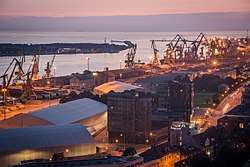Port of Klaipėda
The Port of Klaipėda is a seaport located in Klaipėda, Lithuania. It is one of the few ice-free ports in northernmost Europe, and the largest in Lithuania. It serves as a port of call for cruise ships as well as freight transport. Regular passenger ferry lines connect to Kiel, Karlshamn and other European cities.[2]

| |
| Location | |
|---|---|
| Country | Lithuania |
| Location | Klaipėda, Lithuania |
| Coordinates | 55.717778°N 21.1125°E |
| UN/LOCODE | LTKLJ[1] |
| Details | |
| Owned by | Government of Lithuania |
| Chief Executive Officer | Arvydas Vaitkus |
| Statistics | |
| Vessel arrivals | 6 572 (2017) |
| Annual cargo tonnage | 46.58 million (2018) |
| Annual container volume | 750 000 TEU (2018) |
| Passenger traffic | 74 716 (2017) |
| Website portofklaipeda.lt | |

History
The city of Klaipėda has been involved in maritime trade since as early as the 13th century, and probably during prehistoric times, since it is located on the Amber Road. For several centuries its administration and its merchants defended the port and competed with the Port of Danzig and the Port of Königsberg. It was heavily fortified. At the beginning of the 20th century the port was transferred to the jurisdiction of the Ministry of Transport of the Republic of Lithuania. Before World War I, the major cargo was timber. During the 20th century, mineral and cellulose enterprises were established in Lithuania, and became port commodities. Infrastructures supporting the fishing and shipbuilding industries were also built.
Current operations
In 1991, after Lithuanian independence was declared, the Klaipėda State Seaport Authority was founded. It administers the port and supports its integration into the larger scheme of Lithuanian transport. The Port Authority is responsible for the maintenance, reconstruction and modernisation of the port infrastructure, while loading and unloading operations are managed by separate independent terminals. The port's land and infrastructure belong to the state, but some privatisization is underway.
The Port of Klaipėda is the most northerly ice-free port in the Eastern part of the Baltic Sea. The port can accommodate ships of up to 250 meters in length with draughts of up to 13.5 meters. The port is served by two railway stations, and highways link Klaipėda to Moscow via Kaunas, Vilnius, and Minsk.
In 1997, 16.13 million tons of cargo were handled at the port, increasing to over 31 million tons in 2010. About 321,000 international passengers transhipped the port of Klaipėda in 2010, on ferries servicing Kiel and Mukran in Germany, Åhus in Sweden, and Copenhagen and Fredericia in Denmark. The port of Klaipėda is also the leading port among the Baltics by handling of containers (472 th. of TEU in 2017).
The World Bank is sponsoring improvements at the port:
The main objectives of the Klaipeda Port Project are to strengthen the long term competitiveness of this Baltic region port, and, to improve environmental conditions, by preventing spills, improving waste reception facilities, and monitoring environmental conditions. The two main components are: 1) Investments in civil works, which will include the rehabilitation of breakwaters at the port entrance, through detailed investigations, and, build an extension of both the northern, and southern breakwaters, to limit wave energy from entering the port. In addition, the channel entrance will be dredged, widened, and deepened, allowing a realignment away from the oil terminal, in accordance with international agreements. Specifically designed monitoring fenders will be installed, combined with steel mooring lines. Safe maneuvers will be ensured following the installation of a wave/current monitoring system. Studies will determine the requirements for marine environment protection, and the financing of necessary equipment, and training. 2) Technical assistance will be provided, through studies to estimate the appropriate level of land lease rates, to avoid cross subsidies with harbor dues, and review lease management contracting, and procurement procedures, and, will focus on privatization practices for port services, and management. Training will be provided for port pilots on skillful navigation practices.
— The World Bank, December 2006
The following table is a snapshot of ships within the port on December 9, 2006.
See also
- History of Klaipėda
- Ports of the Baltic Sea
- DFDS Lisco
References
- "UNLOCODE (LT) - LITHUANIA". service.unece.org. Retrieved 25 April 2020.
- "Archived copy". Archived from the original on 2015-09-25. Retrieved 2015-09-26.CS1 maint: archived copy as title (link)
External links
| Wikimedia Commons has media related to Port of Klaipėda. |